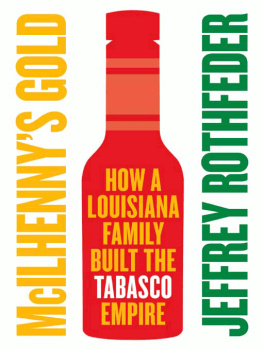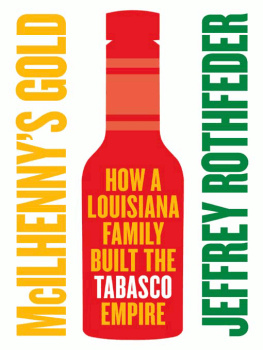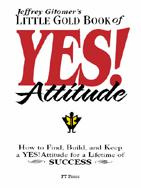Jeffrey Rothfeder - McIlhennys Gold
Here you can read online Jeffrey Rothfeder - McIlhennys Gold full text of the book (entire story) in english for free. Download pdf and epub, get meaning, cover and reviews about this ebook. publisher: HarperCollins, genre: Home and family. Description of the work, (preface) as well as reviews are available. Best literature library LitArk.com created for fans of good reading and offers a wide selection of genres:
Romance novel
Science fiction
Adventure
Detective
Science
History
Home and family
Prose
Art
Politics
Computer
Non-fiction
Religion
Business
Children
Humor
Choose a favorite category and find really read worthwhile books. Enjoy immersion in the world of imagination, feel the emotions of the characters or learn something new for yourself, make an fascinating discovery.
- Book:McIlhennys Gold
- Author:
- Publisher:HarperCollins
- Genre:
- Rating:5 / 5
- Favourites:Add to favourites
- Your mark:
- 100
- 1
- 2
- 3
- 4
- 5
McIlhennys Gold: summary, description and annotation
We offer to read an annotation, description, summary or preface (depends on what the author of the book "McIlhennys Gold" wrote himself). If you haven't found the necessary information about the book — write in the comments, we will try to find it.
McIlhennys Gold — read online for free the complete book (whole text) full work
Below is the text of the book, divided by pages. System saving the place of the last page read, allows you to conveniently read the book "McIlhennys Gold" online for free, without having to search again every time where you left off. Put a bookmark, and you can go to the page where you finished reading at any time.
Font size:
Interval:
Bookmark:
How a Louisiana
Family Built the
Tabasco Empire

To Claudia, my partner, my love
In a plant shed nearly leveled by arson, its once elegant lattice-work reduced to burned shards, Edmund McIlhenny pondered the miracles that he held in his hands. The Civil War had just ended, allowing McIlhenny, his wife and in-laws, the Averys, to return to their island in Louisianas Gulf of Mexico after a two-year exile in Brenham, Texas, that began when they fled in 1863 as Union troops bore down on their home.
Trudging back, much had changed. The Confederacy was no more. The Averys, previously one of the wealthiest plantation owners in Louisiana, were destitute, their Dixie dollars valueless and their slaves emancipated. Edmund McIlhenny, who had made millions as a celebrated banker in New Orleans before the war, was fifty years old, out of work with no prospects. He and Mary Avery, Judge Daniel Dudley Averys daughter, had been married for seven years and still did not have a home of their own.
And if the family was surely disconsolate, what they encountered on Petit Anse (today known as Avery Island)a salty, swampy, isolated corner of south-central Louisiana, a mere ten miles in diameterdid nothing to buoy their spirits. The island was their sole remaining possession of any value. But crossing the narrow bayou, they found it, too, had been despoiled. With the exception of a few slave cabins, all of the homessome palatial, others more humblewere ransacked by Union soldiers. The salt mines were ravaged. The once fertile sugar fields were scorched to bare earth. Avery Island appeared virtually devoid of life, but for a handful of former slaves who had refused to leave, unsure of where to go and what to do with their freedom.
The returning family moved into the old plantation house, although it was in disrepair. Much of the Averys cherished period furniture had been chopped up by Northern troops and used for firewood; priceless finials and balustrades as well as family objets dart had been looted. But the roof wasnt leaking, and the house provided shelter. Judge Avery and his sons hired the ex-slaves to help restore the fields in hopes of growing sugar again. Absent other options, they agreed to work for nothing for a short period, assuming they would receive a salary when revenue began to come in.
Judge Avery was not particularly fond of Edmund McIlhenny; he believed him to be uncouth, undereducated and lacking in sophistication. So he was determined to keep his son-in-law as far away from family plantation operations as he could. Instead, McIlhenny was given the more menial task of tending to the vegetable gardena relatively small plot of artichokes, lettuce, tomatoes, watermelon and Irish potatoes.
While working in this garden, McIlhenny stumbled upon his miraculous discovery. As McIlhenny recounted later, he had just begun to clear the weeds, windborne rubbish and ashen debris in preparation for planting when he was stunned to find a dozen or so stunted red pepper plants, bearing fruit, poking up out of the undergrowth and tangle.
McIlhenny had to think a moment to recall how these plants came to be in Avery Island soil in the first place. In the early days of the Civil War, McIlhenny had met a Confederate soldier with the mysterious name of Friend Gleason, who had given him a handful of chilies just brought back from the Tabasco region of southern Mexico. You will find that these will add exceptional flavor to your food, Gleason told McIlhenny. Intrigued, McIlhenny had planted the seeds from these peppers on the island, just as the Union soldiers were poised to invade. Astonishingly, McIlhenny thought, Gleasons chilies had survivedand thriveddespite the sacking of the island.
McIlhenny remembered stripping a few of the peppers from their stalks and taking them into the plant shed to study them more closely. They were exquisitedeep bloodred in color and perfectly shaped. Although not a religious man, McIlhenny found it impossible to deny the divine qualities of plants that had stood up to hellish destruction, according to family legend. It seemed certain to McIlhenny that these scrawny vines with the picture-postcard peppers were omens pointing to some as yet unclear direction he should take. So he tinkered with the peppers, planting their seeds for future crops and using their juice in recipes, especially for pepper sauces.
The ex-slaves on Avery Island were familiar with hot flavors from their native African and Caribbean cuisines. McIlhenny asked them for advice. Some of them said the pepper juice had to breathe over time before its full taste and character could be brought out. Let it mature and ferment, they told him. Others offered suggestions for ingredients that taste best with peppers. Based on their recommendations, McIlhenny added salt and vinegar to pepper mash and aged the mixture for twenty, thirty, forty days.
When he finally unveiled his concoction, McIlhenny feared the worst. This mishmash, full of disparate flavors, could never have a pleasing taste, he thought. Upon sampling it, though, his concerns were immediately allayed. He was overjoyed by the pungent but rewarding recipe he had cooked up virtually by accident. McIlhennys pepper sauce, he would soon learn, perfectly seasoned fish and meats and superbly fit in with the growing Louisiana hunger for spicy dishes.
McIlhenny shared the sauce with friends, who liked it as well. So he poured the thick wine-red liquid into discarded cologne bottles with narrow necks, added sprinkler fitments so only a drop of the piquant sauce could be dispensed at a time, labeled them E. McIlhenny Tabasco Pepper Sauce and offered them for sale. In the initial shipment in 1869, wholesalers were so excited about the prospects for this fresh and entirely original condiment that they purchased nearly 700 bottles for national distribution at $1 each, equal to about $15 per bottle in todays money. And thus, what we now know as Tabasco sauce was born.
McIlhennys story is an engaging, uplifting narrative of a providential pepper plant that saved the fortune of a once wealthy but now humbled man and his family. The trouble is, large parts of it are false, nothing more than marketing fables Edmund McIlhenny fabricated to promote his new product as one that had risen up out of the depths of the Civil War. This much is known to be true: his ex-slaves did help develop the recipe for Tabasco sauce after the Averys and McIlhenny returned from exile; the dates are correct; and McIlhenny did combine vinegar, salt and pepper mash to produce an instantly profitable product with a novel taste and texture. But virtually all of the most memorable and inexplicable aspects of the storythe appearance of the shadowy soldier who handed McIlhenny the peppers, the plants ability to survive a conflict that in the South primarily produced only victimsare as much invention as Tabasco sauce itself.
Edmund McIlhenny told and retold this tall tale so often that even those closest to him who should have known better, his wife among them, believed it. And the story became so woven into the historical thread of McIlhennys 140-year-old family business that it, or something quite similar, has been repeated without suspicion in virtually every article written about McIlhenny Co. or Tabasco sauce, including an entertaining investigation of life on Avery Island by the respected journalist John McNulty in a 1953 issue of the New Yorker . Indeed, until very recently the credulous saga of Friend Gleason and his stunningly prodigious peppers was the official version of Tabascos origins posted on the products Web site, a factual lapse corrected only grudgingly after indisputable evidence came to light proving that the real story was something a bit less, well, saucyalthough exactly what the real story is even Edmund McIlhennys heirs are unable to say for sure.
Font size:
Interval:
Bookmark:
Similar books «McIlhennys Gold»
Look at similar books to McIlhennys Gold. We have selected literature similar in name and meaning in the hope of providing readers with more options to find new, interesting, not yet read works.
Discussion, reviews of the book McIlhennys Gold and just readers' own opinions. Leave your comments, write what you think about the work, its meaning or the main characters. Specify what exactly you liked and what you didn't like, and why you think so.











